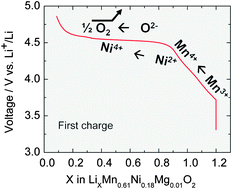In situ investigations of a Li-rich Mn–Ni layered oxide for Li-ion batteries
Abstract
A Li-rich layered

* Corresponding authors
a
CEA-LITEN, 17 rue des Martyrs, 38054 Grenoble Cedex 9, France
E-mail:
loic.simonin@cea.fr
Fax: +33 4 3878 4383
Tel: +33 4 38 78 04 27
b CEA-INAC, 17 rue des Martyrs, 38054 Grenoble Cedex 9, France
c Institute of Ion Beam Physics and Materials Research, Helmholtz-Zentrum Dresden Rossendorf, Dresden, Germany
d CNRS-Institut Neel, 25 avenue des Martyrs, 38042 Grenoble CEDEX 9, France
A Li-rich layered

 Please wait while we load your content...
Something went wrong. Try again?
Please wait while we load your content...
Something went wrong. Try again?
L. Simonin, J. Colin, V. Ranieri, E. Canévet, J. Martin, C. Bourbon, C. Baehtz, P. Strobel, L. Daniel and S. Patoux, J. Mater. Chem., 2012, 22, 11316 DOI: 10.1039/C2JM31205K
To request permission to reproduce material from this article, please go to the Copyright Clearance Center request page.
If you are an author contributing to an RSC publication, you do not need to request permission provided correct acknowledgement is given.
If you are the author of this article, you do not need to request permission to reproduce figures and diagrams provided correct acknowledgement is given. If you want to reproduce the whole article in a third-party publication (excluding your thesis/dissertation for which permission is not required) please go to the Copyright Clearance Center request page.
Read more about how to correctly acknowledge RSC content.
 Fetching data from CrossRef.
Fetching data from CrossRef.
This may take some time to load.
Loading related content
